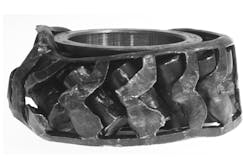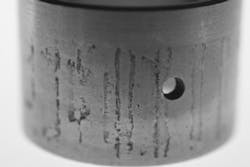Bearings can fail prematurely and unexpectedly even with planning and maintenance. The original equipment manager (OEM) selects bearings for each application in conjunction with the manufacturer’s designed life expectancy based on a fatigued spall failure. For a number of reasons, few bearings reach their full designed life expectancy. The principle causes of damage and premature bearing failure are inadequate/improper lubrication, contamination, overload, and improper handling and installation. These difficulties affect all bearing types.
Unexpected bearing failures may force companies to pay for repairing and replacing the bearing and adjacent components, which may also sustain damage, such as housings and shafts. Bearing failures reduce a plant’s operating efficiency, increase downtime, drive cost of operations up and, in the worst cases, may injure workers.
Improper lubrication
Improper lubrication is the major cause of bearing failure. Issues include: too much lubricant; too little lubricant; using the wrong lubricant; mixing incompatible lubricants; incorrect lubrication intervals; using old, deteriorated grease or oil; and water contamination.
It is important to read OEM and bearing manufacturer recommendations carefully to maximize bearing life within each application. Failure to follow these guidelines may void the bearing warranty and equipment warranty. Their lubricant recommendations are usually based on type, grade, viscosity, any needed additives, amount, application method and application interval.
The bearing manufacturer, OEM and bearing distributor may also be able to make recommendations for storing, handling and inspecting lubricants. The shelf life of lubricants can vary depending on the type of lubricant and storage conditions, and mixing different grades and/or brands of greases or oils can be catastrophic. Lubricants must be compatible to perform their intended job, and significant chemical differences in thickening agents, base oils, additives and other ingredients mean some lubricants should never be mixed with others. Keep lubricants well labeled and dated. It is not a bad idea to also list their areas of use in order to avoid accidental mixing.
On the other hand, trying to standardize one lubricant for all applications in order to avoid accidental mixing could be detrimental to bearing life in some cases. One lubricant almost never works for all applications. The savings gained on the lubricant may be lost in downtime costs.
Often, two identical bearings are used in two identical applications, but because they are located in multiple areas of the same plant, different lubrications are required. Even slight changes in operating conditions can result in bearing and equipment disasters, so the lubricant should be re-examined to determine if a different bearing is required.
People also frequently use old grease without realizing it. If grease tubes that allow for remote access are installed on any bearings, take caution. Many applications call for only a ¼ to ½ ounce of grease every month, which translates to one or two strokes on a standard grease gun. A remote access grease tube that is 4 feet in length will store 24 to 48 months of lubricant and, depending on the environmental conditions, may render the lubricant severely degraded by the time the grease reaches the bearing. When changing lubricant or with a new bearing start-up, always monitor the bearings for signs of trouble. Check bearing temperature continuously or at least periodically. If bearings are operating at more than 180°F, lubricant service life will likely decline considerably.
Other considerations should be taken into account when encountering high operating temperatures for bearings: high ambient or process temperatures; extreme loads (radial or thrust); improper bearing clearance adjustment on tapered bore bearings; improper preloading of angular contact thrust bearings; oversized shafting; and heat transfer from machinery, through the shaft or
housing mount.
Low ambient temperatures can also be a problem for lubricants. Lubricants have a designed operable temperature range, and operating above or below this range, even momentarily, will shorten bearing life. Care should also be given to use the proper lubricant if water contamination is a possibility. Lubricants are available that will not break down in the presence of water.
Etching and corrosion
Seal selection & maintenance
Properly sealing bearings is critical for guarding against contamination and keeping lubricant in play. The bearing manufacturer can assist with what constitutes a proper match between seals and application. The manufacturer can also help the user understand equipment performance, assembly requirements, lubrication, shaft orientation and other environmental factors.
Below are general suggestions for selecting and maintaining seals:
- Use seals that will withstand environmental/operating conditions.
- When possible, install external shields to avoid debris buildup on and around seals.
- Routinely check radial lip seals for flexibility, hardening, cracking and shaft contact.
- Inspect for leaks and replace damaged seals quickly.
- Avoid purging excessive grease past lip seals. They can lose contact and effectiveness, and in severe cases they can be dislodged from the housing.
- Use caution when using water, steam or compressed-air sprays when cleaning equipment. Many seals cannot stand up to steam or high-pressure sprays. It is easy to damage seals and force contaminants into otherwise clean equipment.
- When taking apart large machinery, avoid lifting with chains, wire ropes or dirty slings that can score sealing surfaces. If seal contact surfaces are worn, resurface and grind them to original specifications for finish and diameter. Wear sleeves may be a good alternative to repair damaged shaft sealing surfaces because they provide a strong lip seal surface and generally outperform original shaft surfaces.
Keep in mind these additional points to prevent contamination from damaging bearings:
- If bearings will be removed for inspections, handle them carefully. Wash and dry them. If they will be immediately reinstalled, follow the correct lubrication and installation methods. If they will be stored, coat them with a preservative, and wrap them in acid-free protective paper.
- Consider routine sampling of the lubricant.
- Make sure any filtration is changed and checked regularly, and never rely on filters alone to prevent contamination.
Overload
Bearings are overloaded when they operate beyond their rated design limits for load, speed or temperature. The greater the overload, the more it shortens bearing life, which may cause the bearing components to fracture.
Some overloads may be caused by inappropriate or unanticipated operations due to changes in production requirements or operator error. Overloads can also be a result of bearing/equipment design. In today’s competitive economic environment, many OEMs design equipment with a lower upfront cost to last only through the warranty period. Equipment and systems with longer warranty periods are generally more robust in design, taking into consideration potential overloads and environmental conditions.
Overloaded bearings should be repaired or replaced because of the risk of further damage and more serious consequences they bring.
Proper handling & storage
Maintenance personnel should be trained in the proper methods and tools to use when handling, removing and installing bearings. Even the most miniscule contaminant or the smallest dent or nick will reduce their performance and reliability.
Bearing damage can often be traced back to improper storage. Bearings should never for any reason be opened until they are ready for installation. Quality bearings come stored with protective coating in anticorrosive wrapping, and they should be unwrapped in a clean environment. After an inspection, apply preservatives and ensure parts are rewrapped.
If bearings are going to be stored or stocked for more than three years, they should be ordered with the specification, "Pack for long- term storage." All bearings should be stored flat in a vibration-free, dry area with a cool, steady temperature and relative humidity conditions at 75 percent at 20°C (68°F), 60 percent at 22°C (72°F) or 50 percent at 25°C (77°F).
Those overseeing the project should also keep detailed records of all maintenance, noting the date, equipment model and serial number, bearing part number, manufacturer brand, and (if applicable) the assembly and serial number. Include the housing or shaft conditions and any other replaced components.
Detailed, accurate records will prove essential when establishing trends in bearing performance, defining service intervals and planning future maintenance. The documentation will form the baseline for troubleshooting equipment issues and bearing damage analysis. Bearing distributors’ account representatives are trained in performing root cause analysis to identify solutions for preventing premature bearing failures. A portion of this analysis is a review of annual or semi-annual detailed purchase history that should bring up any abnormally high usage items and commit to assisting in reducing consumption.
A quality bearing distributor will assist with all bearing-related issues, including making sure users are getting optimum life on every bearing and in every application.
Gary Childress is Motion Industries’ product sales manager of bearings, power transmission and material handling. Motion Industries is a wholly owned subsidiary of Genuine Parts Company. For more information, visit motionindustries.com and bearings.com.



